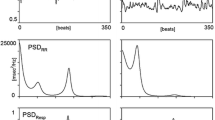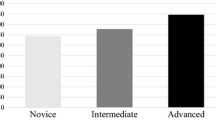Summary
Four autonomic nervous system (ANS) variables: skin potential and resistance, skin blood flow and temperature — plus instantaneous heart rate and respiratory frequency — were simultaneously recorded during sporting competitions. The performances of 15 marksmen and 7 archers were analysed by comparing the variations in the six parameters during a concentration phase prior to shooting and during the shooting (or active) phase proper. The results of the performances distinguished two groups of sportsmen: firstly, the best shots and secondly, the worst shots. Comparison of the autonomic responses between the groups showed statistically significant correlations among the ANS variables. This made possible a relationship between performance characteristics and a percepto-effector factor to be defined. More precisely, this factor was defined as the number of correlations of the measured variables in the two phases, concentration and shooting. A positive relationship was demonstrated —the higher the factor, the better the performance. In addition, the stability of the factor, was greater within the best marksmen and archers groups. A model of the temporal change of the percepto-effector factor in both groups was given in three dimensions. This modelling of performance characteristics gave a visual indication of the differences between best/worst performances.
Similar content being viewed by others
References
Adams JA (1971) A closed-loop theory of motor learning. J Mot Behav 3:111–150
Bernstein AS, Taylor KW, Weinstein E (1975) The phasic electrodermal response as a differentiated complex reflecting stimulus significance. Psychophysiology 12:158–169
Carrol D, Marzillier TS, Watson F (1980) Heart rate and self report changes accompanying different types of releasing imagery. Behav Res Ther 18:273–279
Decety J, Jeannerod M, Germain M, Pastene J (1991) Vegetative response during imagined movement is proportional to mental effort. Behav Brain Res 42:1–6
Denis M (1985) Visual imagery and the use of mental practice in the development of motor skills. Can J Appl Sport Sci 10:45–165
Deschaumes-Molinaro C, Dittmar A, Vernet-Maury E (1991) Relationship between mental imagery and sporting performance. Behav Brain Res 45:37–44
Deschaumes-Molinaro C, Dittmar A, Vernet-Maury E (1992) Autonomic nervous system patterns correlate with mental imagery. Physiol Behav 51:1021–1027
Di Gusto EL, Bond NW (1979) Imagery and the autonomic nervous system: some methodological issues. Percept Mot Skills 48:427–438
Dittmar A (1989) Skin thermal conductivity. A reliable index of skin blood flow and skin hydratation. In: Levêque JL (ed) Cutaneous investigation in health and disease. Dekker, New York: 323–358
Ekman P, Levenson RW, Friesen WV (1983) Autonomic nervous system activity distinguishes among emotions. Science 221:1208–1210
Farah MJ (1984) The neurological basis of mental imagery: a componential analysis. Cognition 18:245–272
Fowles DC, Christie MJ, Edelberg R (1981) Publication recommendations for electrodermal measurements. Psychophysiology 18:232–233
Goldenberg G (1989) The ability of patients with brain damage to generate neural visual images. Brain 112:305–325
Held R (1961) Exposure theory as a factor in maintaining stability of perception and coordination. J Nerv Ment Dis 132:2632
Henry FM (1960) Increased response latency for complicated movements and a “memory-drum” theory of neuromotor reaction. Res Q 31:448–458
Henry FM (1974) Constant and variable performance errors within a group of individuals. J Mot Behav 6:149–154
von Holst E, Mittelstaedt H (1950) Das Reafferenzprinzip (Wechselwirkungen zwischen Zentralnervensystem und Peripherie). Naturwissenschaften 37:464–476
Jeannerod M (1983) Le cerveau-machine, Fayard. Le temps des sciences Odile Jacob, Paris
Keele SW, Posner MI (1968) Processing of feedback in rapid movements. J Exper Psychol 77:353–363
Lacey JI, Batman DE, Vanlehn R (1953) Autonomic response specificity: an experimental study. Psychosom Med 15:8–21
Laszlo JI, Bairstow PJ (1971) Accuracy of movements, peripheral feedback and efference copy. J Mot Behav 3:241–252
Mangina CA (1986) Clinical investigation of a psychophysiological treatment method for learning disabilities. Int J Psychophysiol 4:252–263
Mulder G (1973) Methods and limits of psychophysiology. Psychiatr Neurol Neurochir 76:175–197
Mulder G, Mulder LJM (1981) Information processing and cardiovascular control. Psychophysiology 184:392–402
Passchier J, Helm-Hylkema H (1981) The effect of stress imagery on arousal and its implications for biofeedback of frontalis muscles. Biofeedback self Regul 63:295–303
Pew RW (1966) Acquisition of hierarchical control over the temporal organization of a skill. J Exp Psychol 71:764–771
Pew RW (1974) Human perceptual-motor performance. In: Kantowitz VH (ed) Human information processing: tutorials in performance and cognition. Erlbaum, New York
Rippon G (1990) Individual differences in electrodermal and electroencephalographic asymmetries. Int J Psychophysiol 8:309–320
Robin O, Vernet-Maury E, Dittmar H (1987) The ohmic perturbation duration (OPD index), an autonomic index to objectivate anxiety and pain response. Pain 4:428
Schmidt RA (1975) A schema theory of discrete motor skill learning. Psychol Rev 824:225–260
Schmidt RA, White JL (1972) Evidence for an error detection mechanism in motor skills: a test of Adam's closed-loop theory. J Mot Behav 4:143–153
Vernet-Maury E (1991) The cutaneous bioelectrical signals and their source. Inn Techn Biol Med 121:98–111
Vernet-Maury E, Sicard G, Dittmar A, Deschaumes-Molinaro C (1990) Autonomic nervous system preferential response. Act Nerv Super 32:37–38
Wallin BG, Fagius J (1986) The sympathetic nervous system in man. Aspects derived from microelectrode recordings. TINS 92:63–66
Wilder J (1962) Basimetric approach (law of initial value) to biological rhythms. Ann NY Acad Sci 98:1211–1228
Author information
Authors and Affiliations
Rights and permissions
About this article
Cite this article
Caterini, R., Delhomme, G., Dittmar, A. et al. A model of sporting performance constructed from autonomic nervous system responses. Europ. J. Appl. Physiol. 67, 250–255 (1993). https://doi.org/10.1007/BF00864224
Accepted:
Issue Date:
DOI: https://doi.org/10.1007/BF00864224




